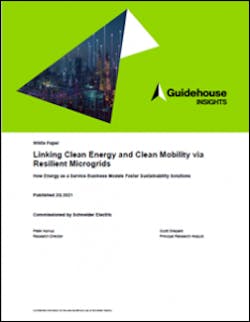Resilient Microgrids Link Clean Energy and Clean Mobility
A new white paper from Schneider Electric explores the link between clean energy and clean mobility, and the role resilient microgrids can play.
Get the full report
As electric vehicle (EV) adoption increases in the US, utilities need a way to both manage the demand from EV chargers and take advantage of the value they can provide the grid. Resilient microgrids can be the key to linking renewables, EVs and advanced software systems by providing real-time optimization of diverse energy sources. According to the paper, “microgrids can support EV charging and EVs can also support microgrids.” The benefits include flexibility, reliability and resilience, and decreased development and operational costs.
Energy as a service (EaaS) business models are a promising part of the solution, as “providers offer microgrids wrapped around EV charging stations with no upfront capital costs for the end user. Under this scenario, the risk for project performance falls on the shoulders of the solutions provider and its financial partners,” says the paper.
“An integrated approach recognizing the needs of clean energy and clean mobility investments is paramount. The technologies required to facilitate these transitions will need to be capable of tying together real-time data on electricity demand, the demands being placed on the legacy distribution network, the microgrid, the building site’s demand for electricity, and, finally, the load created by active EV charging.” — Schneider Electric, “Linking Clean Energy and Clean Mobility via Resilient Microgrids: How Energy as a Service Business Models Foster Sustainability Solutions”
There are four main drivers for integrating EVs and microgrids, according to the paper. First, with an 18-24 month time frame, traditional utility upgrades take too long. Second, the reliability of the US grid is declining. Third, EVs can provide grid services by intelligently managing the use of their onboard batteries. Finally, advances in digitalization controls means EVs can be integrated into distribution networks.
The author goes on to explain how EV fleets offer the best “potential to provide grid services due to overall available capacity of loads or mobile batteries.” The paper illustrates this point with a case study on Maryland’s Brookville bus fleet microgrid. Maryland has set the goal of electrifying half of its bus fleet by 2030 and the case study shows how one county is using an EaaS agreement to overcome fleet electrification and microgrid barriers at the same time. According to the paper, “the project is a first-of-its-kind EaaS EV fleet electrification infrastructure project.”
The paper explains seven important policies that states can implement to encourage the link between clean mobility and clean energy microgrids.
Download the full report, “Linking Clean Energy and Clean Mobility via Resilient Microgrids: How Energy as a Service Business Models Foster Sustainability Solutions” from Schneider Electric to learn more.
About the Author
Kathy Hitchens
Special Projects Editor
I work as a writer and special projects editor for Microgrid Knowledge. I have over 30 years of writing experience, working with a variety of companies in the renewable energy, electric vehicle and utility sector, as well as those in the entertainment, education, and financial industries. I have a BFA in Media Arts from the University of Arizona and a MBA from the University of Denver.

